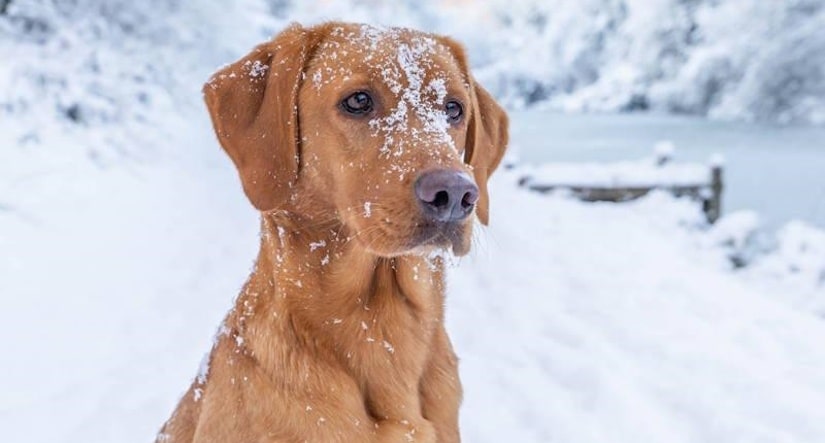Snow is a fascinating phenomenon for many dogs. They love to play, run, and dig in the white, fluffy, and cold substance that covers the ground in winter. Some dogs also love to eat snow, either as a snack or a drink. But why do dogs eat snow? And is it safe for them to do so?
Dogs eat snow for various reasons, such as curiosity, taste, thirst, playfulness, and genetics. However, eating snow can also pose some risks for dogs, such as hypothermia, upset stomach, or exposure to toxic substances.
In this article, we will provide you with some information and tips on why dogs love eating snow, what are the potential dangers, and how to prevent or manage them.
Reasons Why Dogs Eat Snow
For many dogs, eating snow is a fun winter activity. They seem to enjoy the sensory experience of catching snowflakes on their tongue and chewing the cold ice crystals. However, experts say there are several theories that may better explain the motivation behind dogs’ appetite for snow. Let’s explore some of the main reasons why dogs are drawn to consuming snow.
It’s a Form of Play
Chewing, eating, and playing with snow can be a great source of enjoyment and sensory stimulation for dogs. According to Dr. Jennifer Coates, DVM, “Eating snow gives dogs something cold and interesting to chew, similar to chewing ice cubes.” The satisfaction dogs get from the texture and coldness of snow may be enough reason for them to keep coming back for more. It simply serves as a form of play.
It Soothes Their Throat
Another common theory is that dogs eat snow because it cools down their throats and provides relief. A study published in the journal Applied Animal Behaviour Science in 2015 found that dogs demonstrate a preference for colder foods and fluids on hot days, likely because it helps regulate their body temperature.
Snow can serve the same function when dogs are overheated or thirsty. The cold snow soothes irritation in their throats much like when we drink cold water or eat ice pops to cool off.
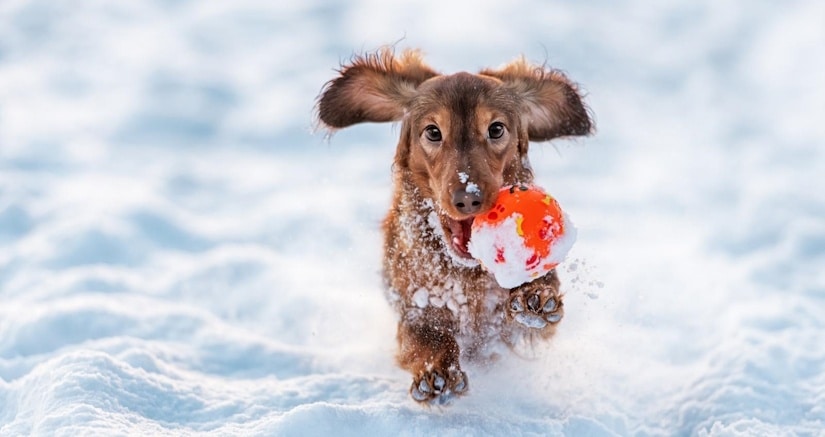
They’re Attracted to the Scent
Experts also surmise that the smell of snow intrigues dogs, luring them into eating it. A fresh blanket of snow has a very particular scent that we may not notice, but dogs with their highly sensitive noses likely find it appealing.
According to veterinarian Dr. Kurt Venator, dogs may smell food particles, chemicals, dust, and other interesting scents in the snow. Their keen sense of smell drives them to sample snow here and there as they catch a whiff of something that smells good buried in the icy powder.
It’s a Natural Behavior
Another factor is that eating snow is an innate behavior for dogs. Wild dogs and wolves consume snow and ice to obtain extra water during colder months. So when domestic dogs get the chance, their ancestral instincts kick in and they eat snow without a second thought.
Veterinarian Dr. Ann Hohenhaus explains that “Dogs’ wild ancestors ate snow for water. The behavior is inherited from the wolf.” This tendency to eat snow when they see it is simply hardcoded in most dogs’ DNA.
It May Indicate a Health Problem
However, while snow-eating is normal dog behavior, in some cases it could signal an underlying health issue. Dr. Jerry Klein, Chief Veterinary Officer for the American Kennel Club, states that “Increased water intake is a well-known sign of kidney disease, diabetes, Cushing’s disease, and other conditions.”
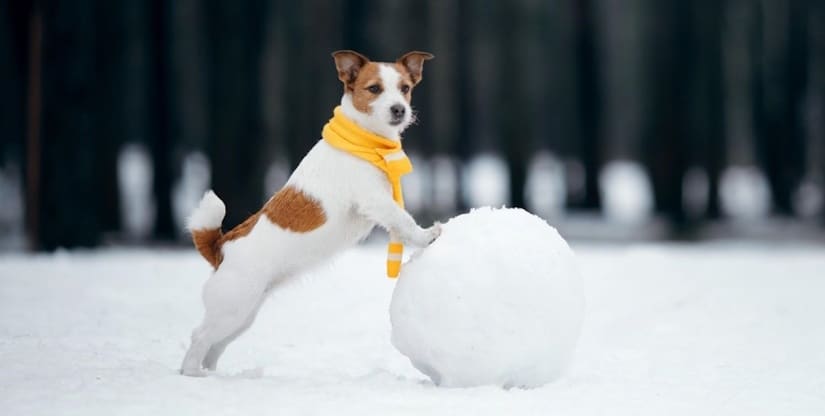
So if your dog seems obsessively preoccupied with eating snow, it may be wise to monitor their water intake and have them examined by a vet, just in case. Some type of malnutrition or disease could be driving their snow cravings.
Pica Disorder
In some cases, dogs may develop an unhealthy obsession with eating snow and other non-food items. This eating compulsion stems from a condition called pica.
Some signs that pica may lead to excessive snow eating:
- Eating odd or inedible things like snow, dirt, grass, rocks.
- Obsessively over-consuming snow and specific objects.
- Seeking and ingesting anything other than regular food.
- Abnormal appetite for things that have no nutritional value.
- Snow eating that seems compulsive.
Pica can have behavioral or medical causes like stress, anxiety, boredom, attention seeking, malnutrition, or nutrient deficiencies. If your dog is obsessively eating snow, talk to your vet to address any underlying issues driving this behavior.
Is It Safe for Dogs to Eat Snow?
As long as the snow is clean, it’s safe for dogs to eat in small quantities. The danger comes primarily from toxic substances, such as ice melt or antifreeze, that might contaminate the snow. And eating snow in large quantities could dangerously lower your dog’s body temperature or cause an upset stomach.
Another danger is that your dog might bite down on or consume harmful objects, such as sticks, rocks or trash that’s buried beneath the snow. These could break teeth, cause choking or, if swallowed, cause intestinal damage or blockage that could necessitate surgery.
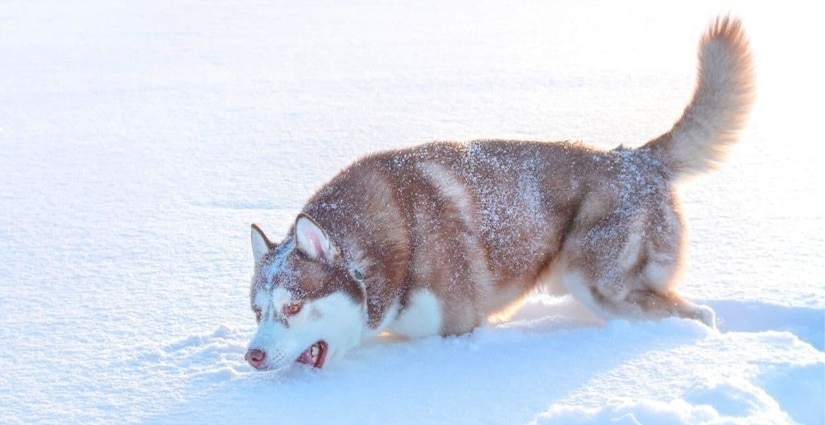
Never let your dog eat dirty, discolored or partially melted snow, or snow that covers roads, sidewalks or other heavily trafficked areas. And under no circumstances should you allow your dog to eat snow that’s been driven on or piled up by a snowplow.
If your dog ate snow that gives you cause for concern, give your vet a call.
Risks and Benefits of Dog Eating Snow
Eating snow can have both positive and negative effects on your dog’s health and well-being. Here are some of the risks and benefits of dog eating snow:
Eating snow is not a problem in and of itself. Indeed, “the prevailing scientific opinion is it’s OK for your dog to eat clean, fresh snow in small amounts,” says Dr. Kurt Venator, chief veterinary officer at Purina.
However, that doesn’t make it an entirely risk-free behavior. In fact, eating snow can be downright dangerous when the snow in question is concealing foreign objects or contaminated with toxic chemicals.
Some of the potential risks of eating snow for dogs are:
Risks
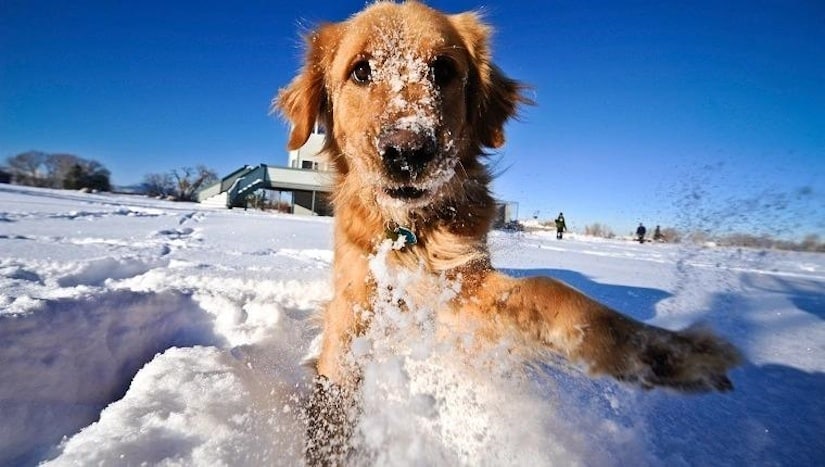
- Hypothermia: Eating too much snow can lower your dog’s body temperature and cause hypothermia, which is a dangerous condition that can lead to organ failure and death if not treated promptly. Signs of hypothermia include shivering, lethargy, weakness, slow breathing and heart rate, and pale gums.
- Upset stomach: Eating too much snow can also upset your dog’s stomach and cause vomiting or diarrhea. This can lead to dehydration and electrolyte imbalance, which can also be life-threatening if not corrected. Signs of dehydration include dry mouth, sunken eyes, loss of skin elasticity and increased heart rate.
-
Toxicity: Eating contaminated snow can expose your dog to toxic substances such as ice melt or antifreeze. Ice melt can irritate your dog’s mouth and gastrointestinal tract and cause drooling, vomiting or diarrhea.
Antifreeze can cause kidney failure and death if ingested even in small amounts. Signs of antifreeze poisoning include drunkenness, seizures, coma and death.
- Injury: Eating snow that contains sharp or hard objects can injure your dog’s mouth, teeth or digestive system. Sticks, rocks or trash can cause cuts, fractures or perforations that can lead to infection or internal bleeding. Signs of injury include bleeding, pain, swelling or difficulty eating.
Benefits
- Hydration: Eating clean snow can help your dog stay hydrated in cold weather when liquid water may be scarce or frozen. Hydration is essential for your dog’s health and performance as it helps regulate body temperature, transport nutrients and oxygen, flush out toxins and lubricate joints and tissues.
- Cooling: Eating snow can also help your dog cool down their body temperature if they are overheated or panting excessively. Cooling is important for your dog’s comfort and safety as it prevents heatstroke, which is a potentially fatal condition that can cause organ damage and death. Signs of heatstroke include excessive panting, drooling, weakness, collapse and seizures.
- Pleasure: Eating snow can provide your dog with pleasure and enjoyment as they explore the world with their mouth. Pleasure is important for your dog’s mental and emotional well-being as it reduces stress, boredom and frustration and increases happiness, confidence and motivation.
- Play: Eating snow can also be part of your dog’s play behavior as they interact with the environment and have fun. Play is important for your dog’s physical and social development as it improves their fitness, agility, coordination and communication skills and strengthens their bond with you and other dogs.
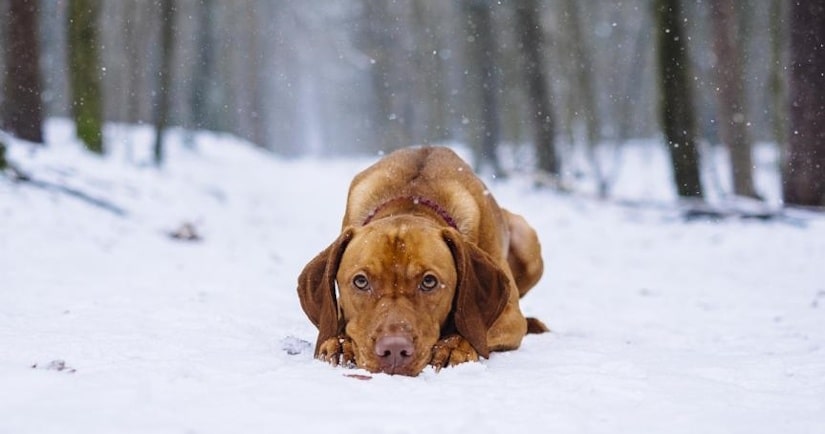
How to Discourage Your Dog from Eating Snow
It might be impossible to prevent dogs from eating snow entirely, but here are a few things you can do to discourage your dog from eating too much snow:
- Provide fresh water: Make sure your dog has access to fresh, clean water at all times, especially in cold weather. You can use a heated water bowl or add warm water to their regular bowl to prevent freezing. You can also add some chicken broth or wet food to their water to make it more appealing.
- Monitor their health: Check your dog’s health regularly and consult your vet if you notice any signs of illness or injury. If your dog has a health condition that makes them eat snow excessively, follow your vet’s advice on how to treat it. You can also ask your vet about supplements or medications that can help with dehydration or stomach issues.
- Avoid contaminated snow: Keep your dog away from snow that is dirty, discolored or partially melted, or snow that covers roads, sidewalks or other heavily trafficked areas. Use a leash or a fence to prevent your dog from wandering off and eating snow that might be contaminated with toxic substances such as ice melt or antifreeze1.
- Remove harmful objects: Before letting your dog play in the snow, inspect the area for any sharp or hard objects that might be buried beneath the snow. Remove any sticks, rocks or trash that could injure your dog’s mouth, teeth or digestive system. You can also use a muzzle or a basket to prevent your dog from biting down on anything dangerous1.
- Limit their intake: Allow your dog to eat only small amounts of snow at a time and stop them if they eat too much. You can use a command such as “leave it” or “drop it” to interrupt their behavior and redirect their attention to something else. You can also offer them a treat or a toy as a reward for leaving the snow alone.
- Engage them in other activities: Provide your dog with alternative activities that are more fun and rewarding than eating snow. You can play games with them such as fetch, tug-of-war or hide-and-seek, or teach them new tricks or commands. You can also give them interactive toys or puzzles that stimulate their mind and keep them busy.
Well, That’s a Wrap
In conclusion, the intriguing phenomenon of dogs loving to eat snow may be attributed to a combination of factors. Their innate curiosity, the novelty of the cold, and the sensory stimulation snow provides could all play a part in this frosty fascination.
Additionally, some experts suggest that ancestral instincts may also be at play, as snow consumption could have once been a survival tactic in the wild.
While the exact reasons might remain partially shrouded in mystery, one thing is clear: Watching our canine companions joyfully munch on snow is a charming reminder of the unique and delightful behaviors that make dogs such beloved companions in our lives.
